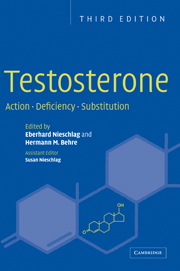Book contents
- Frontmatter
- Contents
- List of contributors
- Preface
- 1 Testosterone: an overview of biosynthesis, transport, metabolism and non-genomic actions
- 2 The androgen receptor: molecular biology
- 3 Androgen receptor: pathophysiology
- 4 Behavioural correlates of testosterone
- 5 The role of testosterone in spermatogenesis
- 6 Androgens and hair: a biological paradox
- 7 Androgens and bone metabolism
- 8 Testosterone effects on the skeletal muscle
- 9 Androgens and erythropoiesis
- 10 Testosterone and cardiovascular diseases
- 11 Testosterone and erection
- 12 Testosterone and the prostate
- 13 Clinical uses of testosterone in hypogonadism and other conditions
- 14 Pharmacology of testosterone preparations
- 15 Androgen therapy in non-gonadal disease
- 16 Androgens in male senescence
- 17 The pathobiology of androgens in women
- 18 Clinical use of 5α-reductase inhibitors
- 19 Dehydroepiandrosterone (DHEA) and androstenedione
- 20 Selective androgen receptor modulators (SARMs)
- 21 Methodology for measuring testosterone, DHT and SHBG in a clinical setting
- 22 Synthesis and pharmacological profiling of new orally active steroidal androgens
- 23 Hormonal male contraception: the essential role of testosterone
- 24 Abuse of androgens and detection of illegal use
- Subject Index
11 - Testosterone and erection
Published online by Cambridge University Press: 18 January 2010
- Frontmatter
- Contents
- List of contributors
- Preface
- 1 Testosterone: an overview of biosynthesis, transport, metabolism and non-genomic actions
- 2 The androgen receptor: molecular biology
- 3 Androgen receptor: pathophysiology
- 4 Behavioural correlates of testosterone
- 5 The role of testosterone in spermatogenesis
- 6 Androgens and hair: a biological paradox
- 7 Androgens and bone metabolism
- 8 Testosterone effects on the skeletal muscle
- 9 Androgens and erythropoiesis
- 10 Testosterone and cardiovascular diseases
- 11 Testosterone and erection
- 12 Testosterone and the prostate
- 13 Clinical uses of testosterone in hypogonadism and other conditions
- 14 Pharmacology of testosterone preparations
- 15 Androgen therapy in non-gonadal disease
- 16 Androgens in male senescence
- 17 The pathobiology of androgens in women
- 18 Clinical use of 5α-reductase inhibitors
- 19 Dehydroepiandrosterone (DHEA) and androstenedione
- 20 Selective androgen receptor modulators (SARMs)
- 21 Methodology for measuring testosterone, DHT and SHBG in a clinical setting
- 22 Synthesis and pharmacological profiling of new orally active steroidal androgens
- 23 Hormonal male contraception: the essential role of testosterone
- 24 Abuse of androgens and detection of illegal use
- Subject Index
Summary
Introduction
Erectile dysfunction has been defined by the NIH Consensus Development Panel on Impotence as “the inability to attain and/or maintain penile erection sufficient for satisfactory sexual performance” (NIH Consensus Development Panel on Impotence 1993). Today, it is generally accepted that the pathogenesis of erectile dysfunction is multifactorial, and several emotional, physical and medical factors contribute to the degree of the dysfunction. The prevalence of erectile dysfunction increases with age, and results of various surveys indicate an overall prevalence in males aged between 30 and 80 years of approximately 20% (Shabsigh and Anastasiadis 2003; Braun et al. 2003).
Physiology of erection
Erection can be regarded as a complex neurovascular process that can be initiated by recruitment of penile afferent signals (reflexogenic erection) and by visual, acoustic, tactile, olfactory and imaginary stimuli (psychogenic erection). Several brain regions have been identified that are involved in the initiation of penile erection. The effect of testosterone on these central mechanisms is described in depth in Chapter 4.
At the penile level, the erection is determined by the contractile state of the smooth muscles. Contracted smooth muscle cells in the flaccid penis minimize the blood flow into the sinuses of the corpora cavernosa. With sexual stimulation, three hemodynamic factors are essential for achievement of erection with full tumescence and rigidity:
(1) Relaxation of cavernosal smooth muscle cells which leads to intracavernosal reduction of resistance,
(2) increased arterial inflow into the sinuses of the corpora cavernosa by relaxation of smooth muscles of the arterial vessels, and
(3) restriction of venous outflow by compression of intracavernosal and subtunical venous plexus (for review van Ahlen and Hertle 2000; Shabsigh and Anastasiadis 2003).
- Type
- Chapter
- Information
- TestosteroneAction, Deficiency, Substitution, pp. 333 - 346Publisher: Cambridge University PressPrint publication year: 2004
- 3
- Cited by

